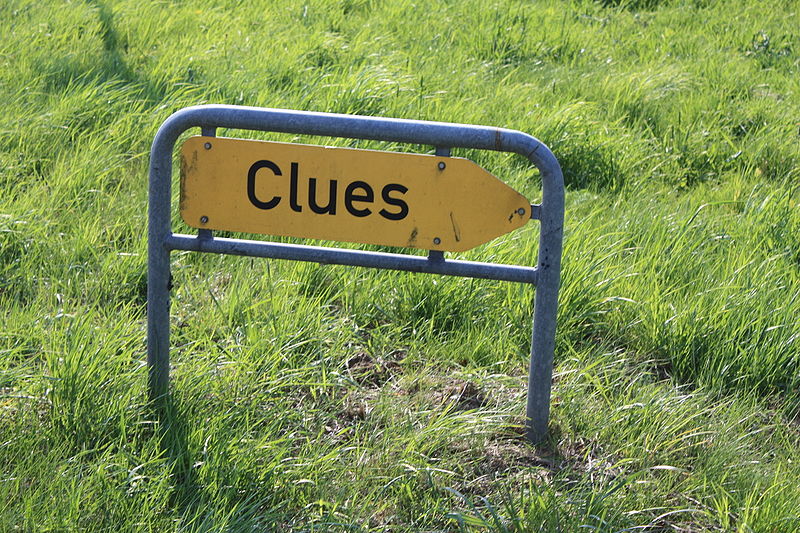
Source: CIAS 2013 - 2014 Jaguar F-Type Convertible (8514795962),
Michael Gil, Wikimedia
When you imagine a perfect car ride, you take into account all of your senses.
- Sight: The view outside the windows
- Sound: A great stereo system and the sounds of birds singing as you drive
- Smell: Fresh air, fragrant flowers
- Taste: Snacks on the way
- Touch: A smooth and comfortable ride

Source: Clues 0068, Syker Fotograf, Wikimedia
When you begin your journey of close reading, look for examples of words that appeal to your five senses, and then infer the author’s message from them.
When authors use imagery, they first consider how to be so specific that the readers can imagine exactly what is being described. The readers feel as though they, too, are experiencing the object or scene described. Let’s play a little game to see how this concept works. Read each description below and try to imagine the object. If you need another clue, click to reveal until you know what the object is.


Source: USEV Sun Rise 2, David Ledford, Flickr
Until you read all of the clues, you may have thought the answer was something else. For instance, after looking at only the first two clues in series 1, you might have thought it described a dog. In series 2, you could have thought “airplane!” after reading the first three clues. The more complete the author’s description, the better the reader can picture what is described. Accomplished authors use description with exceptional precision and thoroughness to paint detailed images.
Authors next consider how to select details in creating a particular effect, feeling, or mood to convey to the reader. Much of the skill in creating meaning is to create a meaningful picture. Readers must have sharp skills to draw inferences, or conclusions, from the sensory images to understand on the figurative level.
The way we determine figurative meaning is to look for clues in the types of words the author uses. For example, both of the following sentences could be summarized as “The day was sunny.” However, because of the words selected, each has moods or meaning different from the other.
This example suggests a calm, happy feeling about the sun. We know this because of the words “soft,” “filtered,” “lovely,” and “glow.”
The second example portrays an agonizing scene, indicated by phrases and words such as “scorching hot,” “blinded,” “trudged,” and “sweating profusely.”
From these examples, you can see that the kinds of words and the number of details help us determine meaning.

Source: shadow balancing, zen Sutherland, Flickr

Source: Shiny plum, Fir0002, Wikimedia
Let’s practice this skill of making inferences. Read the poem “This Is Just To Say” by William Carlos Williams and think about how the author creates images to help you understand the meaning. As a fun fact, you might like to know that Williams was known as an imagist poet, meaning that he was able to convey his meaning entirely through the use of images. The imagist poets of the early twentieth century favored the use of precise language, exact words that were never vague or indefinite, to form an image. Imagists also limited the words they used to those that were essential for portraying their image.
 After you read the poem, complete the questions below. For each question, first click to choose the best answer to the question. Then, use your notes to write the text evidence. Be sure to explain how you knew the answer. The first one is done for you.
After you read the poem, complete the questions below. For each question, first click to choose the best answer to the question. Then, use your notes to write the text evidence. Be sure to explain how you knew the answer. The first one is done for you. 1. What do you think the speaker’s goal is in this poem?
 How do you know? Answer using your notes. Then, check your understanding for a sample response.
How do you know? Answer using your notes. Then, check your understanding for a sample response. 
Source: Half eaten plum, Morten Batbukt, Flickr
Sample Response:
Although the speaker apparently ate some plums that someone else was “saving / for breakfast,” I don’t think he feels regret about it or wants to deny it. Instead, he admits to doing so at the beginning the poem: “I have eaten / the plums.” Then, he describes how tempting they were because they were “so sweet/ and so cold.”
2. What type of sensory imagery is most prominent in the poem?
 How do you know? Answer using your notes. Then, check your understanding for a sample response.
How do you know? Answer using your notes. Then, check your understanding for a sample response. Sample Response:
Although the words “so cold” and “icebox” provide touch imagery, “eaten,” “breakfast,” “delicious” and “so sweet” are images of taste.
3. Which word do you think best characterizes the speaker in this poem?
 How do you know? Answer using your notes. Then, check your understanding for a sample response.
How do you know? Answer using your notes. Then, check your understanding for a sample response. Sample Response:
The speaker in the poem “This Is Just To Say” seems to feel satisfied or justified in eating the plums, which someone else may have been “saving / for breakfast.” The poem suggests that the speaker was not especially hungry but ate the plums anyway because “they were delicious / so sweet / and so cold,” thus almost irresistible. The fact that Williams ends the poem with this description rather than the line “Forgive me” leads me to believe that the speaker feels more justified than guilty about eating the plums.
4. Where do you think this poem is set?
 How do you know? Answer using your notes. Then, check your understanding for a sample response.
How do you know? Answer using your notes. Then, check your understanding for a sample response. 
Source: Day 214: Stick it on the
fridge, Dan Callahan, Flickr
Sample Response:
Using the words “breakfast” and “icebox” (another word for refrigerator) seem to place the poem in a kitchen. You might be able to picture this poem as a note the speaker left on the refrigerator for someone who is coming in for breakfast. Since the speaker wrote the note or poem and is not relaying this information in person, you can assume that both the speaker and the plums are gone from the scene. However, as a close reader, you can still determine the nature of the relationship between the speaker and the other person using our skills of inference.
5. How would you characterize the relationship of the speaker to the person he is addressing in the poem?
 How do you know? Answer using your notes. Then, check your understanding for a sample response.
How do you know? Answer using your notes. Then, check your understanding for a sample response. Sample Response:
I would guess the two people have a loving relationship because the speaker takes time to apologize for eating the plums by saying, “Forgive me.” He also acknowledges that the other person was planning to eat the plums when he guesses that “you were probably / saving” them for breakfast. These lines make it seem that the speaker cares about the other person’s feelings.
6. Based on what you have inferred about the relationship between the two people, what would you say is the overall tone of the poem?
 How do you know? Answer using your notes. Then, check your understanding for a sample response.
How do you know? Answer using your notes. Then, check your understanding for a sample response. Sample Response:
The two people referred to in the poem—“I” and “you”—appear to have a friendly, comfortable relationship. I imagine that the person who comes upon the poem and the missing “plums / that were in / the icebox” would smile about how the speaker could not resist the delicious fruit. The recipient of the note will probably feel that most people would have done the same thing. Therefore, it seems that the tone is good humored.

Source: Yay! You Made It! Joe Schlabotnik, Flickr
You have just used inference to determine a variety of meanings including mood, setting, characterization, and theme or underlying message.
Imagery, as you have just seen, can be found in the most ordinary places. Let’s continue our ride through the study of literature to find additional examples of sensory imagery.